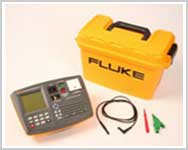PAT - Portable Appliance Testing
The Inspection and tests that are to be carried out are described below, with tests varying dependant upon the class of appliance. However, the testing of all appliances is essential as part of regular maintenance to ensure conformity to Electricity at Work Regulations.
Inspection
Without passing the initial inspection, no appliance can be passed as safe. The inspection involves examination of the plug top, lead and the casing of the equipment. The plug top is checked for the correct fuse size, adequate cord grip, correct polarity and tightness of terminations, cracking, heat damage and a plug with insulating pins conforming to current BS standards. The casing of equipment is checked for any visual damage or cracks and any holes or vents that are apparent must not have a radius greater than 6mm. Allso there must not be any live parts within 80mm of the aperture
Class of Equipment
| Class 1 | This is any equipment that has an earth connection from the mains supply. In most cases this equipment will have exposed earthed metal work and live parts will have basic insulation, e.g., fan heater, computer etc. |
| Class 2a | This equipment has no exposed metalwork and has two layers of insulation, e.g., desk calculator, dictation machine, etc. |
| Class 2b | This equipment may have exposed unearthed metalwork, which will be separated from live parts by two layers of insulation, e.g., power drill, etc. |
| Class 3 | This equipment operates from a power supply less than 50v AC and has basic insulation with no earthed metalwork, e.g., lap top computer, mobile phone, etc. |
